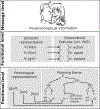Language processing from the perspective of electrical stimulation mapping
- PMID: 29996708
- PMCID: PMC6330152
- DOI: 10.1080/02643294.2018.1485636
Language processing from the perspective of electrical stimulation mapping
Abstract
Electrical Stimulation (ES) is a neurostimulation technique that is used to localize language functions in the brain of people with intractable epilepsy and/or brain tumors. We reviewed 25 ES articles published between 1984 and 2018 and interpreted them from a cognitive neuropsychological perspective. Our aim was to highlight ES as a tool to further our understanding of cognitive models of language. We focused on associations and dissociations between cognitive functions within the framework of two non-neuroanatomically specified models of language. Also, we discussed parallels between the ES and the stroke literatures and showed how ES data can help us to generate hypotheses regarding how language is processed. A good understanding of cognitive models of language is essential to motivate task selection and to tailor surgical procedures, for example, by avoiding testing the same cognitive functions and understanding which functions may be more or less relevant to be tested during surgery.
Keywords: Awake surgery; cognitive neuroscience; direct electrical stimulation; language.
Conflict of interest statement
Disclosure statement
No potential conflict of interest was reported by the authors regarding the materials or methods used in this study or the findings reported in this paper.
Figures


References
-
- Allison T, McCarthy G, Nobre A, Puce A, & Belger A (1994). Human extrastriate visual cortex and the perception of faces, words, numbers, and colors. Cerebral Cortex, 4(5), 544–554. - PubMed
-
- Bello L, Galluci M, Fava M, Carraba G, Giussani C, Acerbi F, … Gaini SM (2007). Intraoperative subcortical language tract mapping guides surgical removal of gliomas involving speech areas. Neurosurgery, 60, 67–82. doi:10.1227/01.NEU.0000249206.58601.DE - DOI - PubMed
Publication types
MeSH terms
Grants and funding
LinkOut - more resources
Full Text Sources
Other Literature Sources
